1994 CHEVROLET CORVETTE brake
[x] Cancel search: brakePage 123 of 274
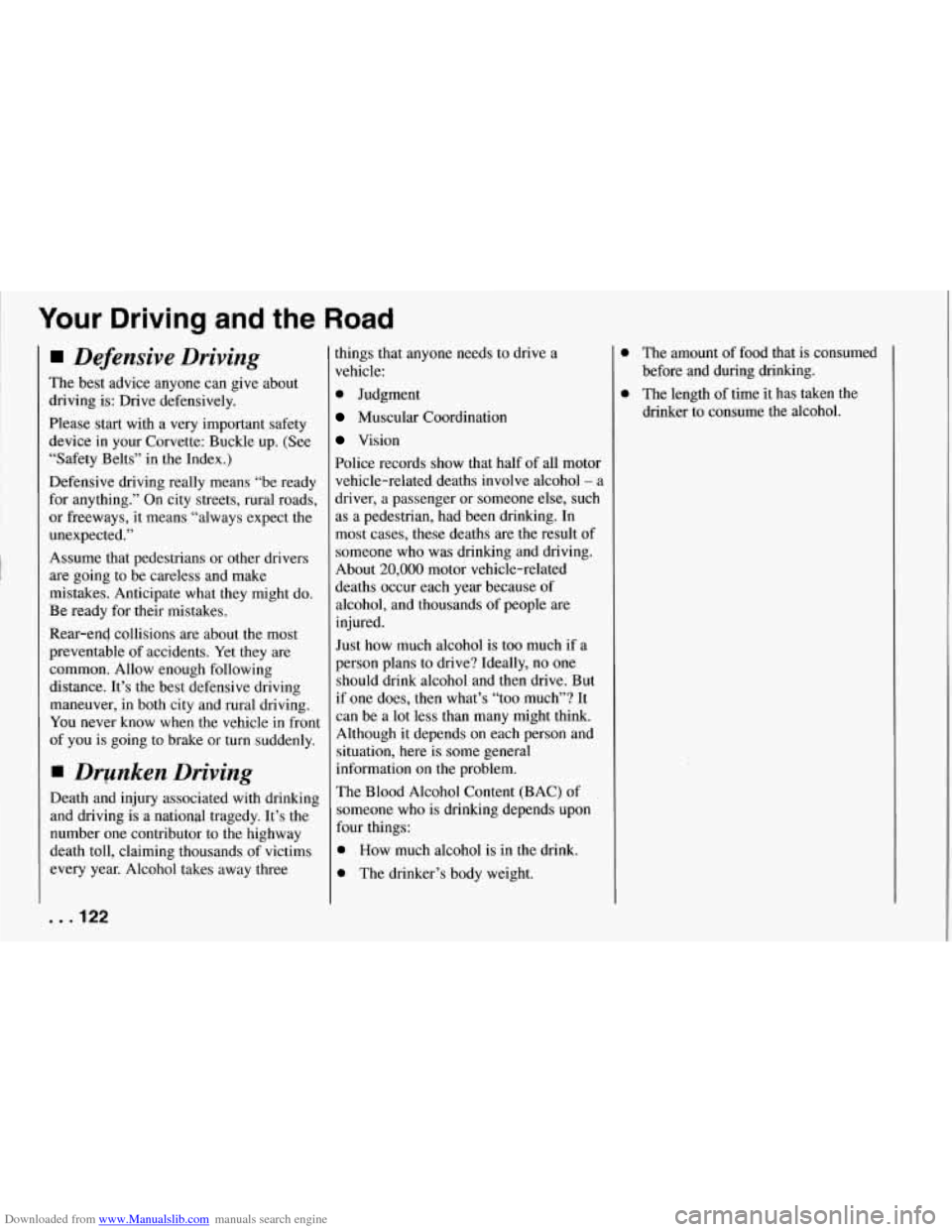
Downloaded from www.Manualslib.com manuals search engine I Your Driving and the Road
Defensive Driving
The best advice anyone can give about
driving is: Drive defensively.
Please start with a very important safety
device in your Corvette: Buckle up. (See
“Safety Belts” in the Index.)
Defensive driving really means “be ready
for anything.” On city streets, rural roads,
or freeways, it means “always expect the
unexpected.’’
Assume that pedestrians or other drivers
are going to be careless and make
mistakes. Anticipate what they might do.
Be ready for their mistakes.
Rear-en4 collisions are about
the most
preventable of accidents. Yet they are
common. Allow enough following
distance. It’s the best defensive driving
maneuver, in both city and rural driving.
You never know when the vehicle
in front
of you is going to brake or turn suddenly.
Drpnken Driving
Death and injury associated with drinking
and driving is a natioqal tragedy. It’s the
number one contributor to the highway
death toll, claiming thousands of victims
every year. Alcohol takes away three
. .I22
things that anyone needs to drive a
vehicle:
0 Judgment
Muscular Coordination
Vision
Police records show that half of all motor
vehicle-related deaths involve alcohol
- a
driver, a passenger or someone else, such
as a pedestrian, had been drinking. In
most cases, these deaths are the result of
someone who was drinking and driving.
About
20,000 motor vehicle-related
deaths occur each year because of
alcohol, and thousands of people are
injured.
Just how much alcohol is too much if a
person plans to drive? Ideally,
no one
should drink alcohol and then drive. But
if one does, then what’s “too much”? It
can be a lot less than many might think.
Although it depends
on each person and
situation, here is some general
information on the problem.
The Blood Alcohol Content (BAC) of
someone who is drinking depends upon
four things:
0 How much alcohol is in the drink.
0 The drinker’s body weight.
0
0
The amount of food that is consumed
before and during drinking.
The length of time
it has taken the
drinker to consume the alcohol.
Page 125 of 274

Downloaded from www.Manualslib.com manuals search engine Your Driving and the Road
There’s something else about drinking
and driving that many people don’t know.
Medical research shows that alcohol in a
person’s system can make crash injuries
worse. That’s especially true for brain,
spinal cord and heart injuries. That means
that if anyone who has been drinking
-
driver or passenger - is in a crash, the
chance
of being killed or permanently
disabled is higher than if that person had
not been drinking. And we’ve already
seen that the chance of a crash itself is
higher for drinking drivers.
. . .124
Control of a Vehicle
You have three systems that make your
vehicle
go where you want it to go. They
are the brakes, the steering and the
accelerator. All three systems have to do
their work at the places where the tires
meet the road.
Sometimes, as when you’re driving on
snow or
ice, it’s easy to ask more of those
control systems than the tires and road
can provide. That means you can lose
control of your vehicle.
Braking
Braking action involves perception time
and reaction time.
First, you have to decide to push on the
brake pedal. That’s perception time. Then
you have to bring up your foot and do it.
That’s reaction time.
Average reaction time is about
314 of a
second. But that’s only
an average. It
might be less with one driver and as long
as two or three seconds or more with another. Age, physical condition,
alertness, coordination, and eyesight all
play a part.
So do alcohol, drugs and
frustration. But even in
314 of a second,
a vehicle moving at
60 mph (100 km/h)
travels 66 feet (20 m). That could be a lot
of distance in an emergency, so keeping
enough space between your vehicle and others is important.
And, of course, actual stopping distances
vary greatly with the surface of the road
(whether it’s pavement or gravel); the
condition of the road (wet, dry, icy); tire
tread; and the condition of your brakes.
Avoid needless heavy braking. Some
people drive in spurts
- heavy
acceleration followed by heavy braking
- rather than keeping pace with traffic.
Page 126 of 274
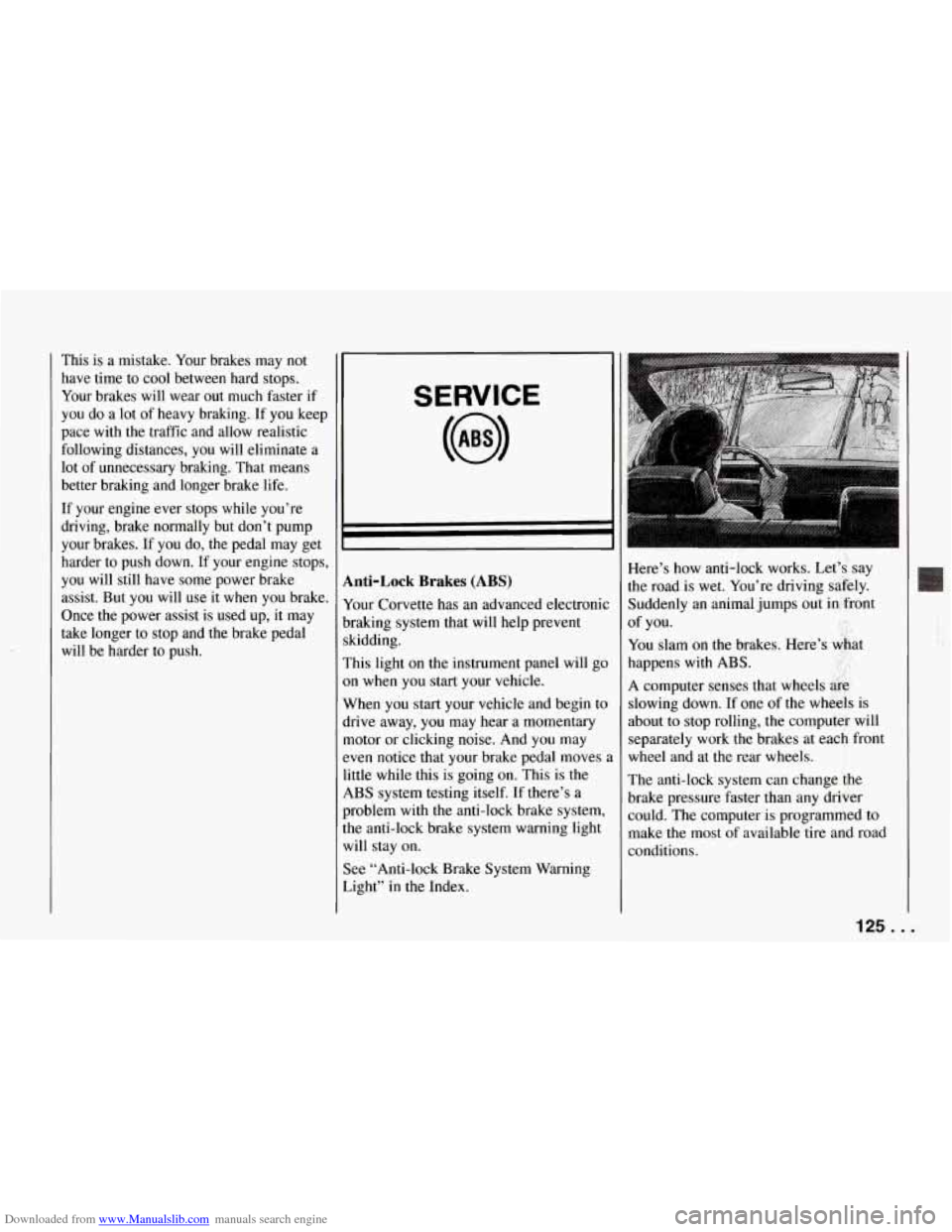
Downloaded from www.Manualslib.com manuals search engine This is a mistake. Your brakes may not
have time to cool between hard stops.
Your brakes will wear out much faster if
you do a lot
of heavy braking. If you keep
pace with the traffic and allow realistic
following distances, you will eliminate a
lot of unnecessary braking. That means
better braking and longer brake life.
If your engine ever stops while you’re
driving, brake normally but don’t pump
your brakes. If you do, the pedal may get
harder to push down. If your engine stops,
you will still have some power brake
assist. But you will use it
when you brake.
Once the power assist is used up, it may
take longer to stop and the brake pedal
will be harder to push.
SERVICE
I
Anti-Lock Brakes (ABS)
Your Corvette has an advanced electronic
braking system that will help prevent
skidding.
This light on the instrument panel will go
on when you start your vehicle.
When you start your vehicle and begin to
drive away, you may hear a momentary
motor or clicking noise. And you may
even notice that your brake pedal moves
,
little while this is going on. This is the
ABS system testing itself. If there’s a
problem with the anti-lock brake system,
the anti-lock brake system warning light
will stay on.
See “Anti-lock Brake System Warning
Light” in the Index. Here’s how anti-lock works. Let’s, say
the road
is wet. You’re driving safely.
Suddenly an animal jumps out in front
You slam on the brakes. Here’s &at
happens with
ABS. ..
A computer senses that wheels &g,
slowing down. If one of the wheels is
about to stop rolling, the computer will
separately work the brakes at each front
wheel and at the rear wheels.
The anti-lock system can change
the
brake pressure faster than any driver
could. The computer is programmed to
make the most of available tire and road
conditions. of
you.
125..,
Page 127 of 274
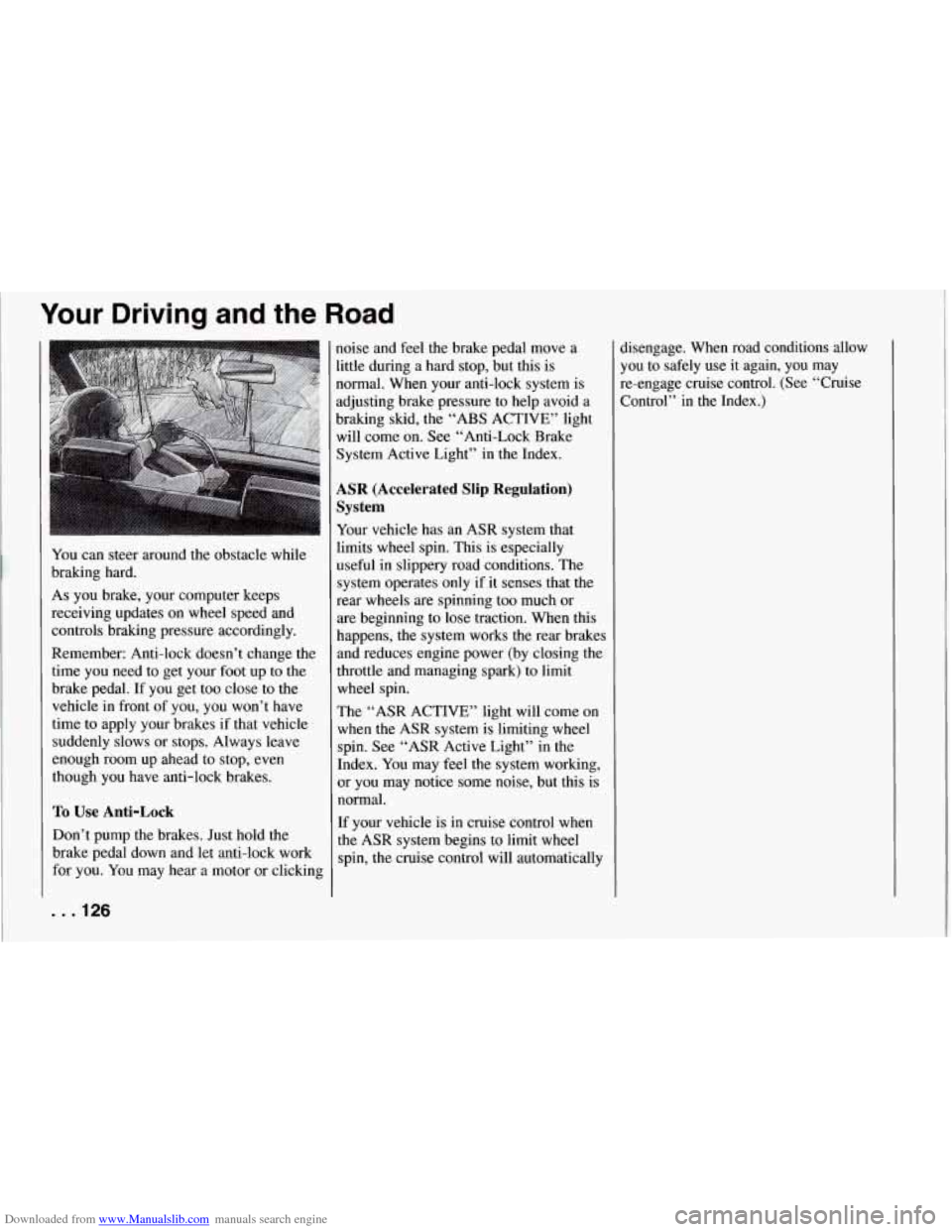
Downloaded from www.Manualslib.com manuals search engine Your Driving and the Road
You can steer around the obstacle while
braking hard.
As you brake, your computer keeps
receiving updates on wheel speed and
controls braking pressure accordingly.
Remember: Anti-lock doesn’t change the
time you need to get your foot up to the
brake pedal.
If you get too close to the
vehicle
in front of you, you won’t have
time to apply your brakes if that vehicle
suddenly slows or stops. Always leave
enough room up ahead to stop, even
though you have anti-lock brakes.
To Use Anti-Lock
Don’t pump the brakes. Just hold the
brake pedal down and let anti-lock work
for you. You may hear a motor or clicking
. . .I26
noise and feel the brake pedal move a
little during a hard stop, but this is
normal. When your anti-lock system is
adjusting brake pressure to help avoid a
braking skid, the “ABS ACTIVE” light
will come on. See “Anti-Lock Brake
System Active Light” in the Index.
ASR (Accelerated Slip Regulation)
System
Your vehicle has an ASR system that
limits wheel spin. This is especially
useful in slippery road conditions. The
system operates only if it senses that the
rear wheels are spinning too much or
are beginning to lose traction. When this
happens, the system works
the rear brakes
and reduces engine power (by closing the
throttle and managing spark) to limit
wheel spin.
The “ASR ACTIVE” light will come on
when the ASR system is limiting wheel
spin. See “ASR Active Light”
in the
Index. You may feel the system working,
or you may notice some noise, but this is
normal.
If your vehicle is in cruise control when
the ASR system begins to limit wheel
spin, the cruise control will automatically disengage. When road conditions allow
you to safely use it again, you may
re-engage cruise control. (See “Cruise
Control” in the Index.)
Page 129 of 274

Downloaded from www.Manualslib.com manuals search engine Your Driving and the Road
the tires against the road surface makes it
possible for the vehicle to change its path
when you
turn the front wheels. If there’s
no traction, inertia will keep the vehicle
going in the same direction. If you’ve
ever tried to steer a vehicle
on wet ice,
you’ll understand this.
The traction you can get in a curve
depends on the condition of your tires and
the road surface, the angle at which
the
curve is banked, and,your speed. While
you’re in a curve, speed is the one factor
you can control.
Suppose you’re steering through a sharp
curve. Then you suddenly accelerate.
Both control systems
- steering and
acceleration
- have to do their work
where the tires meet the road. Unless
your
ASR system is on, adding the
sudden acceleration can demand too
much of those places. You can lose
control.
What should you do if this ever happens?
Ease up on the accelerator pedal, steer the
vehicle the way you want it to go, and
slow down.
Speed limit signs near curves warn that
you should adjust your speed. Of course,
the posted speeds are based on good
weather and road conditions. Under less favorable conditions
you’ll want to go
slower.
If you need to reduce your speed as
you
approach a curve, do it before you enter
the curve, while your front wheels are
straight ahead.
Try to adjust your speed
so you can
“drive”. through the curve. Maintain
a reasonable, steady speed. Wait to
accelerate until you are out of
the curve,
and then accelerate gently into the
straightaway.
Steering in Emergencies
There are times when steering can be more
effective than braking. For example, you
come over a hill and find a truck stopped
in your lane, or a car suddenly pulls out
from nowhere, or a child darts out from
between parked cars and stops right in
front of you. You can avoid these problems
by braking
- if you can stop in time. But
sometimes you can’t; there isn’t room.
That’s the time for evasive action
-
steering around the problem.
Your Corvette can perform very well in
emergencies like these. First apply your
brakes. It is better to remove as much speed as you can from a possible collision.
Then steer around the problem, to the left
or right depending on the space available.
An emergency like this requires close
attention and a quick decision. If you are
holding the steering wheel at the recommended
9 and 3 o’clock positions,
you can turn it a full
180 degrees very
quickly without removing either hand. But you have to act fast, steer quickly,
and just as quickly straighten the wheel
once you have avoided the object.
The fact that such emergency situations
are always possible is
a good reason to
practice defensive driving at all times and
wear safety belts properly.
Page 131 of 274
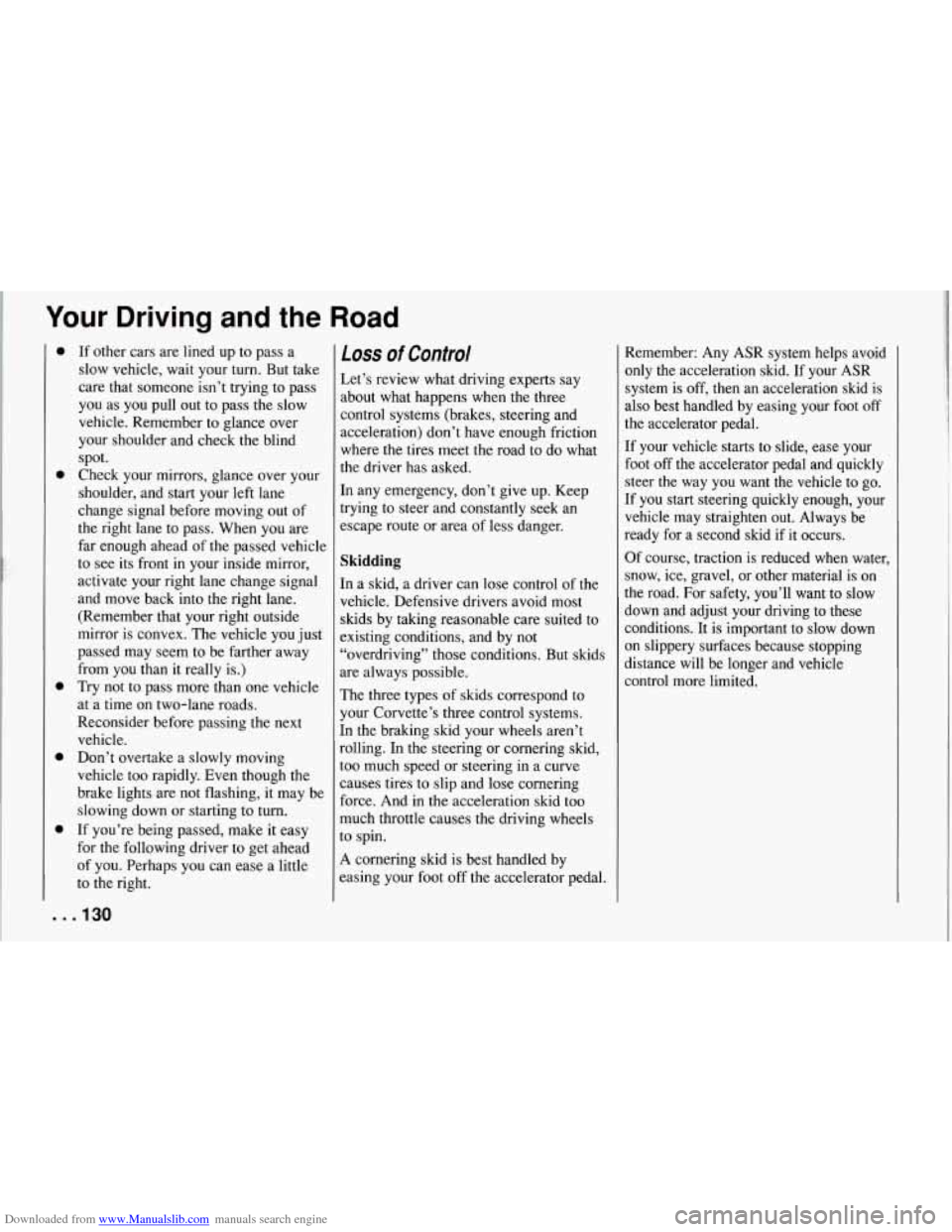
Downloaded from www.Manualslib.com manuals search engine Your Driving and the Road
0
0
..
If other cars are lined up to pass a
slow vehicle, wait your turn. But take
care that someone isn’t trying to pass
you as you pull out to pass the slow
vehicle. Remember to glance over
your shoulder and check the blind
spot.
Check your mirrors, glance over your
shoulder, and start your left lane
change signal before moving out of
the right lane to pass. When you are
far enough ahead
of the passed vehicle
to see its front
in your inside mirror,
activate your right lane change signal
and move back into the right lane.
(Remember that your right outside
mirror is convex. The vehicle you just
passed may seem to be farther away
from you than it really is.)
Try not to pass more than one vehicle
at a time on two-lane roads.
Reconsider before passing the next vehicle.
Don’t overtake a slowly moving
vehicle too rapidly. Even though the
brake lights are not flashing, it may be
slowing down or starting
to turn.
If you’re being passed, make it easy
for the following driver to get ahead
of you. Perhaps you can ease a little
to the right.
,130
Loss of Control
Let’s review what driving experts say
about what happens when the three
control systems (brakes, steering and
acceleration) don’t have enough friction
where the tires meet the road to do what
the driver has asked.
In any emergency, don’t give up. Keep
trying to steer and constantly seek an
escape route or area of less danger.
Skidding
In a skid, a driver can lose control of the
vehicle. Defensive drivers avoid most
skids by taking reasonable care suited to
existing conditions, and by not
“overdriving” those conditions. But skids
are always possible.
The three types of skids correspond to
your Corvette’s three control systems.
In the braking skid your wheels aren’t
rolling. In the steering or cornering skid,
too much speed or steering in a curve
causes tires to slip and lose cornering
force. And in the acceleration skid too
much throttle causes the driving wheels
to spin.
A cornering skid
is best handled by
easing your foot
off the accelerator pedal. Remember: Any
ASR system helps avoid
only the acceleration skid. If your ASR
system is
off, then an acceleration skid is
also best handled by easing your foot off
the accelerator pedal.
If your vehicle starts to slide, ease your
foot
off the accelerator pedal and quickly
steer the way you want the vehicle to go.
If you start steering quickly enough, your
vehicle may straighten out. Always be
ready for a second skid if it occurs.
Of course, traction is reduced when water,
snow, ice, gravel, or other material is on
the road. For safety, you’ll want to slow
down and adjust your driving to these
conditions. It is important to slow down
on slippery surfaces because stopping
distance will be longer and vehicle
control more limited.
Page 134 of 274
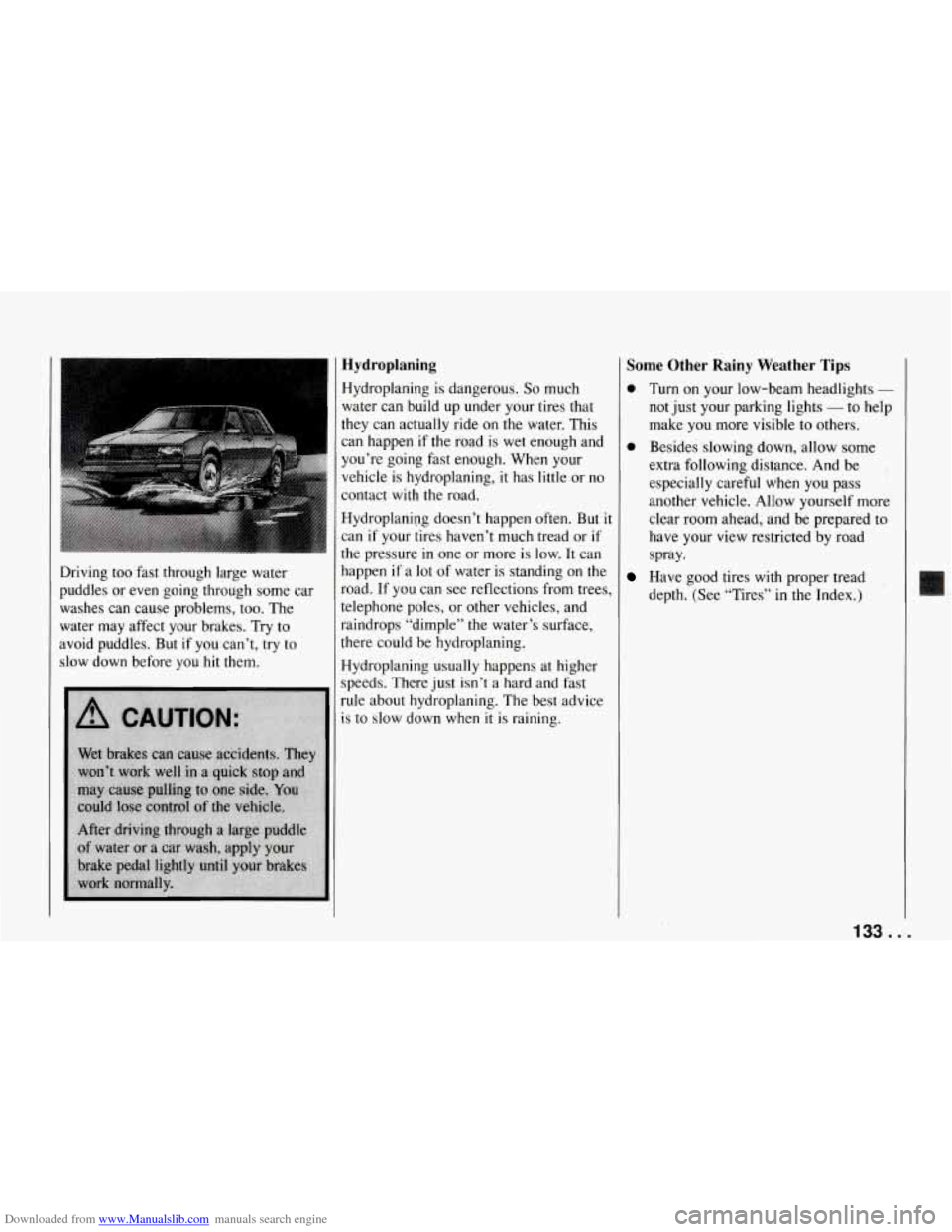
Downloaded from www.Manualslib.com manuals search engine Driving too fast through large water
puddles or even going through some car washes can cause problems, too. The
water may affect your brakes. Try to
avoid puddles.
But if you can’t, try to
slow down before you
hit them.
Hydroplaning
Hydroplaning is dangerous. So much
water can build up under your tires that
they can actually ride
on the water. This
can happen if the road is wet enough and
you’re going fast enough. When your
vehicle is hydroplaning, it has little or
no
contact with the road.
Hydroplaning doesn’t happen often. But it
can
if your tires haven’t much tread or if
the pressure in one or more is low. It can
happen if a lot of water is standing on the
road.
If you can see reflections from trees,
telephone poles, or other vehicles, and
raindrops “dimple” the water’s surface,
there could be hydroplaning.
Hydroplaning usually happens at higher
speeds. There just isn’t a hard and fast
rule about hydroplaning. The best advice
IS to slow down when it is raining.
Some Other Rainy Weather Tips
0 Turn on your low-beam headlights -
not just your parking lights - to help
make you more visible to others.
0 Besides slowing down, allow some
extra following distance. And be
especially careful when you pass
another vehicle. Allow yourself more
clear room ahead, and be prepared to
have your view restricted by road
spray.
Have good tires with proper tread
depth. (See “Tires” in the Index.)
133 ...
Page 137 of 274
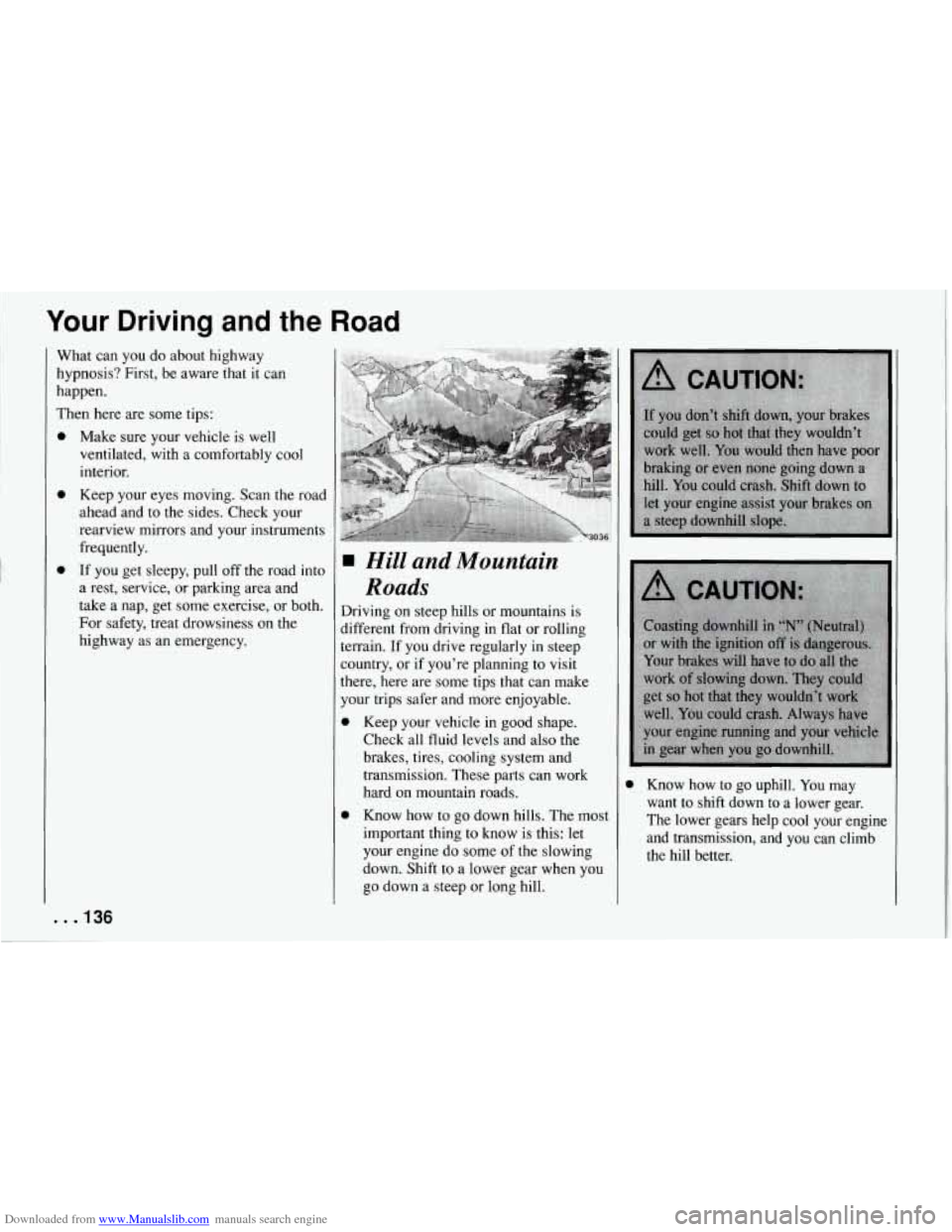
Downloaded from www.Manualslib.com manuals search engine Your Driving and the Road
What can you do about highway
hypnosis? First, be aware that
it can
happen.
Then here are some tips:
0 Make sure your vehicle is well
ventilated, with a comfortably cool
interior.
0 Keep your eyes moving. Scan the road
ahead and to the sides. Check your
rearview mirrors and your instruments
frequently.
0 If you get sleepy, pull off the road into
a rest, service, or parking area and
take a nap, get some exercise, or both.
For safety, treat drowsiness on
the
highway as an emergency.
Hill and Mountain
Roads
Driving on steep hills or mountains is
jifferent from driving in flat or rolling
terrain. If you drive regularly in steep
zountry, or if you’re planning to visit there, here are some tips that can make
your trips safer and more enjoyable.
Keep your vehicle in good shape.
Check all fluid levels and also the
brakes, tires, cooling system and
transmission. These parts can work
hard on mountain roads.
Know how to go down hills. The most
important thing to know is this: let
your engine do some
of the slowing
down. Shift to a lower gear when you
go down a steep or long hill.
0 Know how to go uphill. You may
want to shift down to a lower gear.
The lower gears help cool your engine and transmission, and you can climb
the hill better.
. . .136